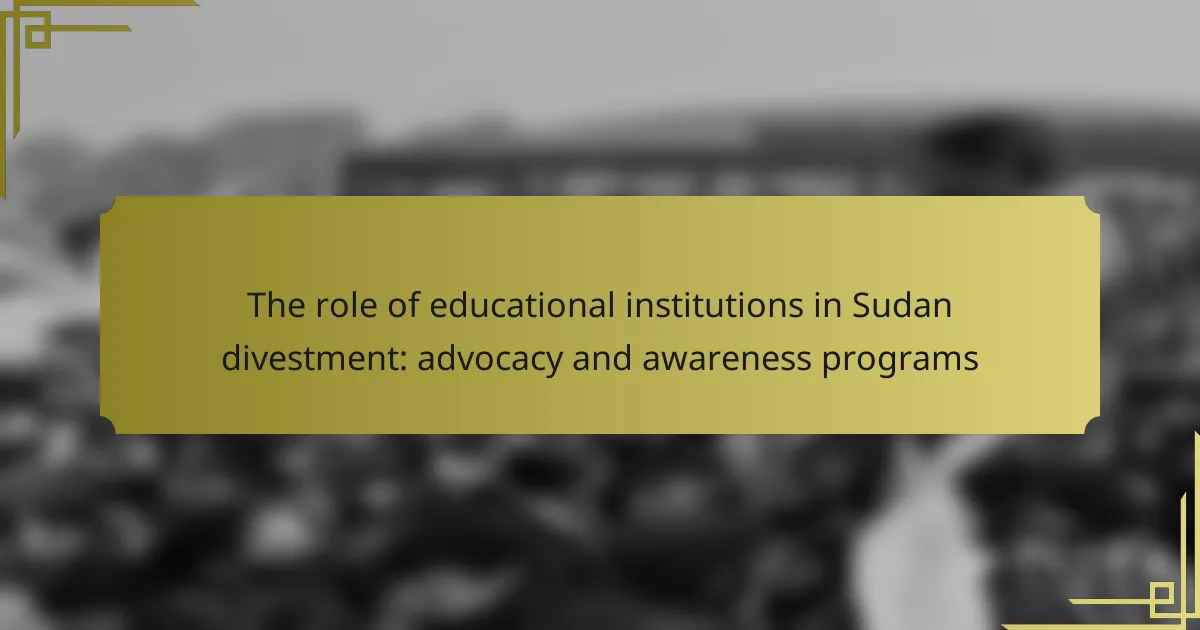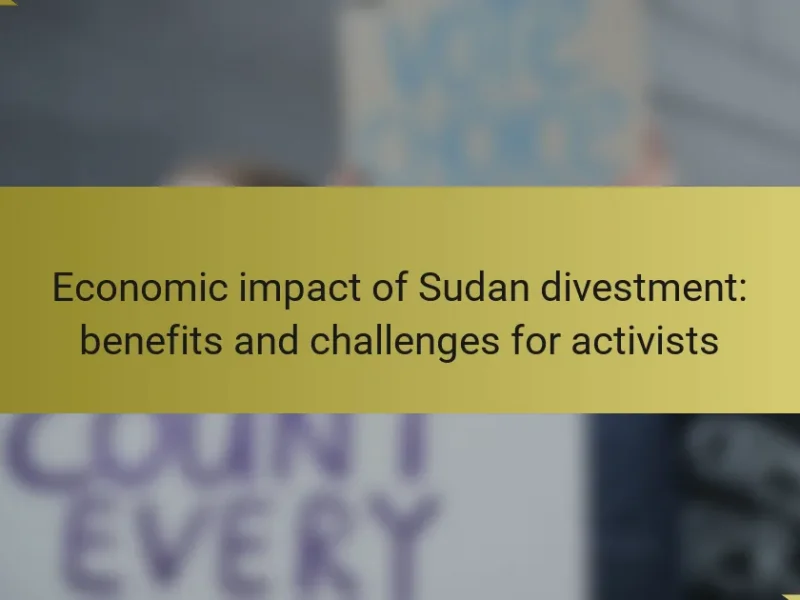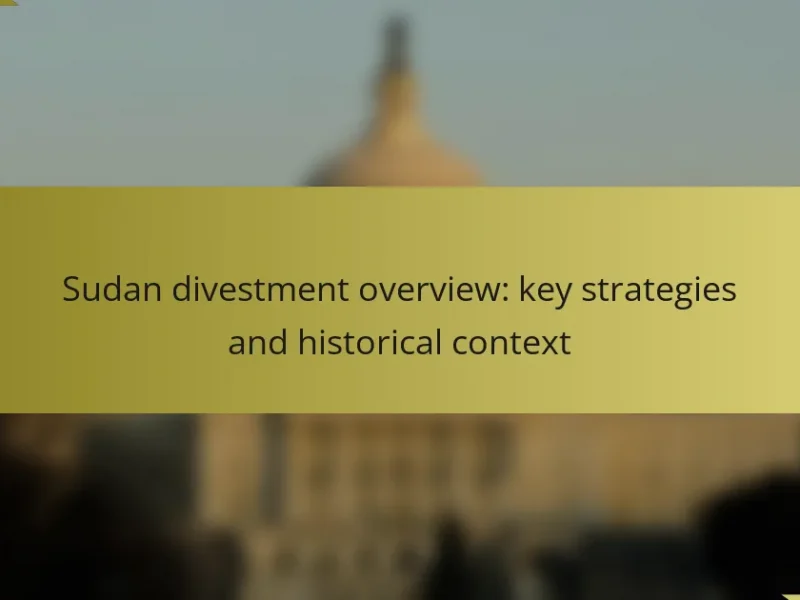Educational institutions are pivotal in advocating for Sudan divestment and promoting ethical investment practices. They engage students and the community through awareness campaigns, seminars, and partnerships with non-governmental organizations (NGOs) to highlight the socio-economic impacts of divestment in conflict zones. Despite facing challenges such as financial dependency on conflicting investments and differing stakeholder opinions, these institutions strive to foster a culture of social responsibility. Their advocacy efforts aim to enhance informed decision-making regarding divestment and contribute to meaningful policy changes. This article outlines the strategies employed by educational institutions, the challenges they encounter, and the importance of their role in mobilizing support for responsible investment practices.
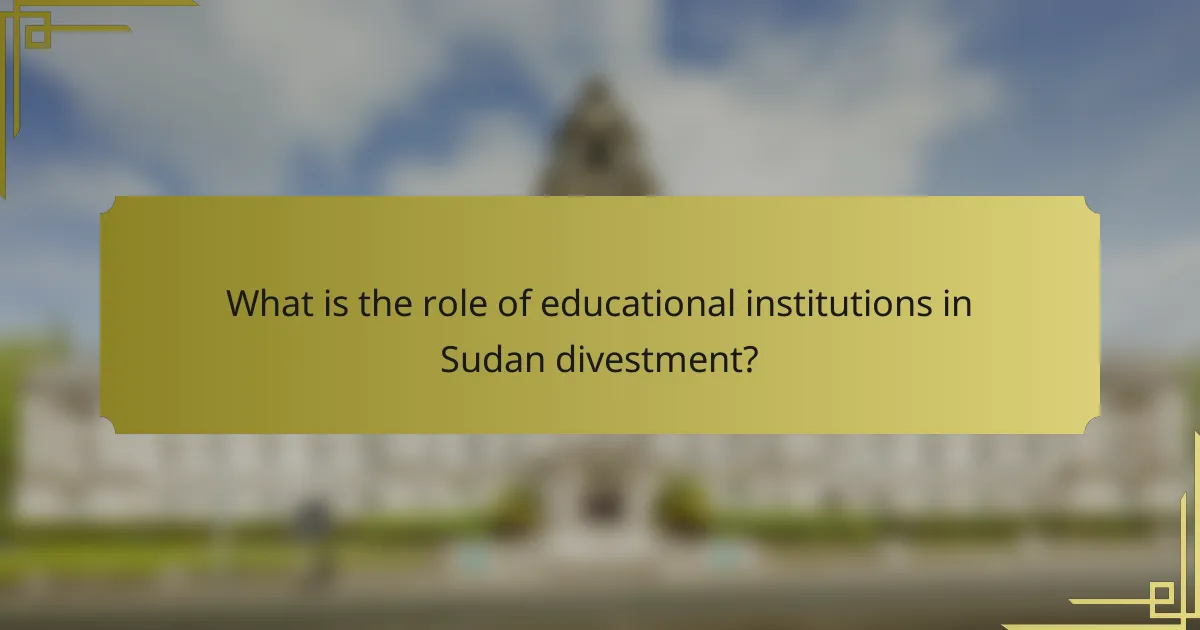
What is the role of educational institutions in Sudan divestment?
Educational institutions play a crucial role in Sudan divestment by raising awareness and advocating for ethical investment practices. They educate students and the community about the socio-economic impacts of divestment. Through research and discussions, these institutions highlight the consequences of investments in conflict zones. They often host seminars and workshops to engage stakeholders in meaningful dialogue. Additionally, universities may collaborate with NGOs to promote responsible investment policies. This partnership can amplify the impact of advocacy efforts. By fostering a culture of social responsibility, educational institutions contribute to informed decision-making regarding divestment. Their role is essential in mobilizing support for ethical financial practices.
How do educational institutions contribute to advocacy in Sudan divestment?
Educational institutions contribute to advocacy in Sudan divestment through research, awareness campaigns, and policy influence. They conduct research that highlights the human rights violations in Sudan. This research provides a factual basis for advocacy efforts. Educational institutions also organize awareness campaigns to inform students and the public about the issues. These campaigns often include lectures, workshops, and discussions. By fostering informed dialogue, they mobilize students to take action. Furthermore, institutions engage in policy advocacy by collaborating with non-profits and government entities. They leverage their academic credibility to influence decision-makers. For instance, many universities have divested from companies operating in Sudan. This action sends a strong message against complicity in human rights abuses. Overall, educational institutions play a pivotal role in driving the divestment movement through informed advocacy.
What specific programs do educational institutions implement for advocacy?
Educational institutions implement various advocacy programs to promote awareness about Sudan divestment. These programs include workshops that educate students on the implications of divestment. They also feature guest lectures from experts in social justice and international relations. Additionally, institutions may organize campaigns to mobilize student and faculty support. Some universities create partnerships with NGOs to amplify their outreach efforts. Others establish student-led organizations focused on advocacy. These initiatives aim to foster dialogue and encourage action within the academic community. Research indicates that such programs enhance student engagement in social issues and promote informed activism.
How do these programs raise awareness about Sudan divestment?
These programs raise awareness about Sudan divestment through educational initiatives and advocacy campaigns. They organize workshops, seminars, and discussions that inform participants about the implications of divestment. Educational materials are distributed to highlight the ethical and economic reasons for divestment from Sudan. Collaborations with student organizations amplify outreach efforts. Social media campaigns engage a broader audience by sharing informative content. Partnerships with local and national NGOs enhance credibility and visibility. Research studies and reports provide factual backing to the divestment argument. These efforts collectively foster a more informed and active community regarding Sudan divestment.
Why is awareness important in the context of Sudan divestment?
Awareness is crucial in the context of Sudan divestment because it mobilizes public opinion and drives action. Increased awareness helps individuals understand the ethical implications of investment in Sudan. Educational institutions play a key role in disseminating information about human rights abuses in the country. They educate students on the impact of divestment on the Sudanese economy and society. Knowledgeable individuals are more likely to advocate for ethical investment practices. Awareness campaigns can influence policymakers to take decisive action. Research shows that informed communities can significantly affect corporate decisions regarding investment. For instance, the Sudan Divestment Task Force has demonstrated that awareness leads to successful divestment initiatives.
How does awareness influence public perception of Sudan divestment?
Awareness significantly influences public perception of Sudan divestment. Increased awareness leads to a better understanding of the issues surrounding divestment. Educational institutions play a crucial role in raising this awareness through advocacy programs. These programs inform students and the public about the socio-political context of Sudan. For instance, campaigns highlighting human rights abuses can mobilize support for divestment. Research indicates that informed individuals are more likely to support ethical investment practices. This correlation can be seen in various university-led initiatives that have successfully prompted divestment from companies operating in Sudan. Therefore, awareness serves as a catalyst for changing public perception and encouraging action toward divestment.
What role does student engagement play in raising awareness?
Student engagement plays a crucial role in raising awareness about Sudan divestment. Engaged students actively participate in advocacy efforts. They organize campaigns, discussions, and events to inform peers. This participation fosters a deeper understanding of the issues at hand. Research shows that engagement increases retention of information. For example, a study by the National Survey of Student Engagement found that active involvement enhances awareness levels. Engaged students often become advocates within their communities. Their efforts amplify the message, reaching broader audiences. Overall, student engagement is vital for effective awareness-raising initiatives.
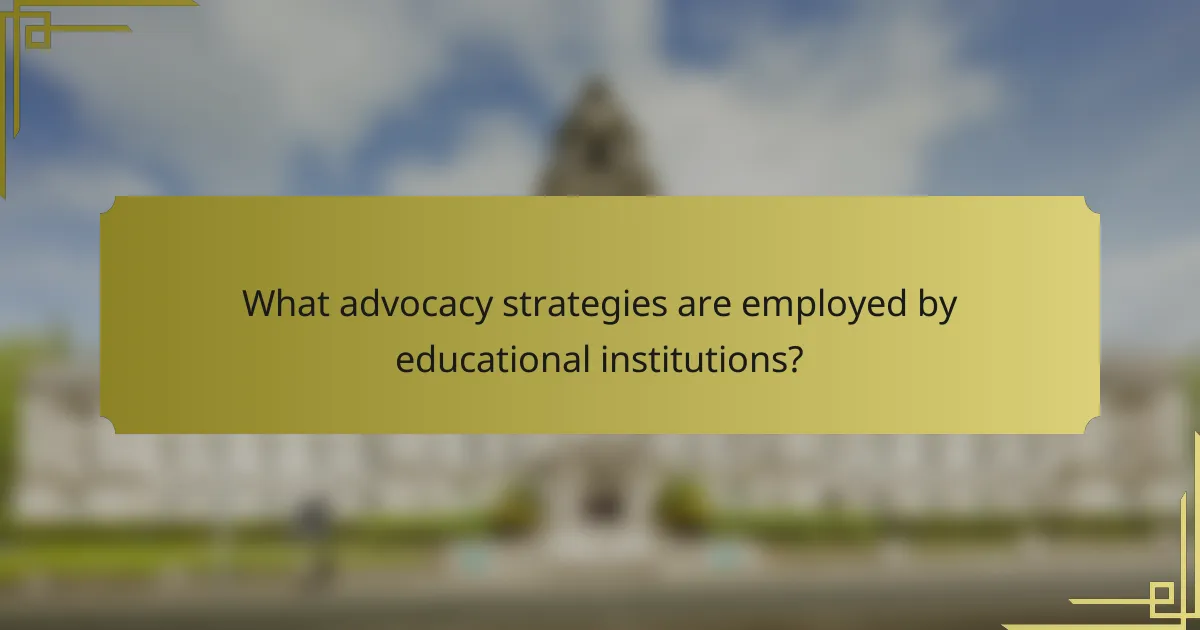
What advocacy strategies are employed by educational institutions?
Educational institutions employ various advocacy strategies to influence policy and raise awareness about issues like Sudan divestment. These strategies include organizing awareness campaigns to educate students and the community. They often engage in partnerships with non-profit organizations to amplify their message. Institutions may also host lectures and panel discussions featuring experts on divestment and related topics. Furthermore, they encourage student activism through clubs and organizations focused on social justice. Research findings indicate that these strategies can lead to increased student engagement and community support. For instance, a study by the American Council on Education found that advocacy efforts significantly impact public perception and policy changes.
How do institutions collaborate with NGOs for advocacy?
Institutions collaborate with NGOs for advocacy by forming strategic partnerships. These partnerships leverage resources, expertise, and networks to amplify messages. Institutions provide research, data, and educational outreach. NGOs contribute grassroots mobilization and community engagement. Joint campaigns raise awareness on critical issues. Collaborative events, such as workshops and seminars, educate stakeholders. Together, they influence policy changes and public opinion. This synergy enhances the effectiveness of advocacy efforts.
What types of partnerships exist between educational institutions and NGOs?
Educational institutions and NGOs engage in various types of partnerships. Collaborative research partnerships focus on conducting studies that benefit both entities. Service-learning partnerships integrate community service into educational curricula. Capacity-building partnerships aim to enhance the skills and resources of both organizations. Advocacy partnerships involve joint efforts to promote social issues or policy changes. Funding partnerships provide financial support for educational initiatives or community programs. Each partnership type addresses specific needs and goals, fostering mutual benefits and social impact.
How do these partnerships enhance advocacy efforts?
Partnerships enhance advocacy efforts by leveraging resources and expertise from multiple stakeholders. They create a unified front that amplifies the message and reach of advocacy campaigns. Collaborations with educational institutions provide access to research, data, and expert opinions. This evidence-based approach strengthens the credibility of advocacy initiatives. Additionally, partnerships can mobilize a larger audience, increasing engagement and support. For instance, joint events or campaigns can attract diverse participants, raising awareness significantly. The combined influence of various organizations often leads to greater policy impact and community involvement.
What methods are used to educate students about Sudan divestment?
Educational institutions use various methods to educate students about Sudan divestment. These methods include workshops and seminars that provide detailed information on the issue. Guest speakers often share personal experiences and insights related to Sudan divestment. Curriculum integration allows for discussions on ethical investing and social responsibility. Student-led campaigns raise awareness through social media and events. Research projects encourage students to investigate the implications of divestment. Collaborative efforts with NGOs enhance educational outreach. Educational materials, such as pamphlets and online resources, are distributed to provide accessible information. These methods collectively aim to foster informed advocacy among students regarding Sudan divestment.
How effective are workshops and seminars in promoting understanding?
Workshops and seminars are effective in promoting understanding. They facilitate interactive learning experiences. Participants engage in discussions and share perspectives. This interaction enhances comprehension of complex topics. Research shows that active participation increases retention of information. For example, a study by the National Training Laboratories found that learners retain 75% of what they practice through discussion. Workshops and seminars also provide real-time feedback. This immediate response helps clarify misunderstandings. Overall, these formats are proven to improve knowledge and awareness significantly.
What resources are available for students to learn about divestment?
Students can access various resources to learn about divestment. Online platforms like Divestment Network provide educational materials and case studies. Universities often host workshops and seminars focusing on divestment strategies. Research papers from academic journals discuss the implications of divestment in detail. Advocacy groups, such as 350.org, offer toolkits for student-led campaigns. Social media channels also disseminate information on divestment efforts. Libraries may have books and articles on ethical investment practices. Collaboration with faculty members can lead to deeper insights into divestment. These resources collectively enhance understanding and engagement in divestment initiatives.
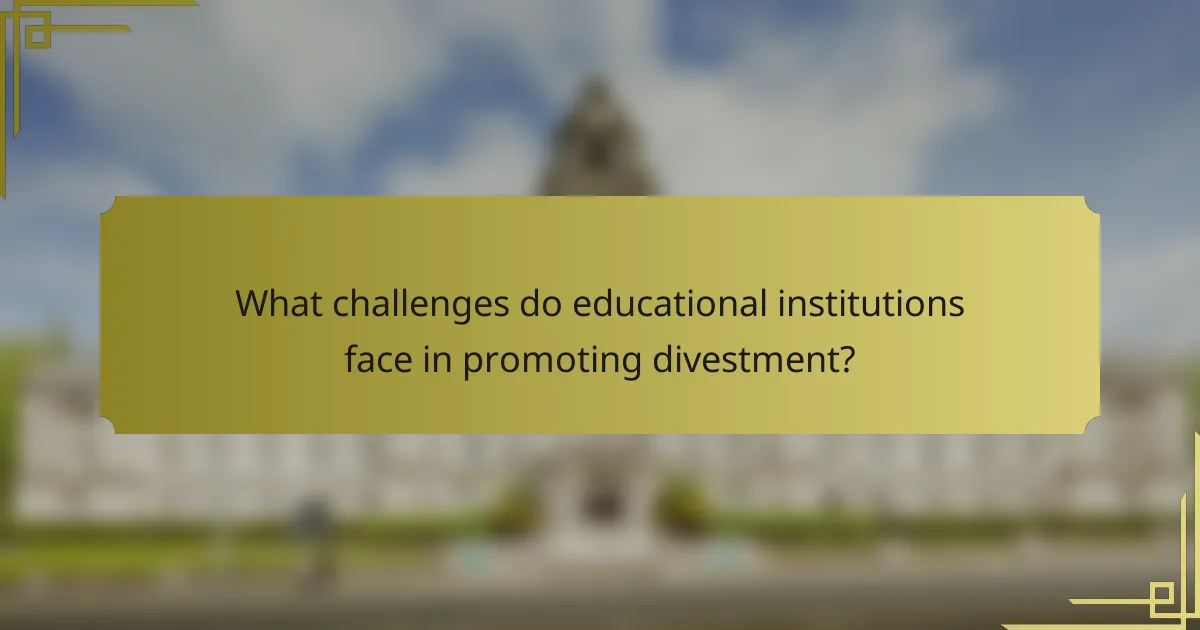
What challenges do educational institutions face in promoting divestment?
Educational institutions face several challenges in promoting divestment. One significant challenge is financial dependency on investments that may conflict with divestment goals. Many institutions rely on returns from fossil fuel investments to fund operations and scholarships. This reliance complicates the decision-making process for divestment.
Another challenge is the lack of consensus among stakeholders. Faculty, students, and alumni may have differing opinions on divestment strategies. This division can lead to conflicts and slow down advocacy efforts. Additionally, educational institutions often prioritize academic freedom and open discourse. This can hinder the ability to take a definitive stance on divestment.
Furthermore, there may be legal and regulatory constraints. Institutions must navigate complex legal frameworks that can affect their investment strategies. This can create hesitation in pursuing divestment initiatives. Lastly, the challenge of raising awareness and educating the community about the implications of divestment persists. Many stakeholders may not fully understand the environmental and social impacts of their investments.
How do political and social factors impact advocacy efforts?
Political and social factors significantly impact advocacy efforts by shaping public perception and influencing policy decisions. Political stability or instability can either facilitate or hinder advocacy initiatives. For example, in regions with strong governance, advocacy groups may find it easier to engage with policymakers. Conversely, in politically volatile contexts, advocacy efforts may face repression or lack of support.
Social factors, such as community values and cultural norms, also play a crucial role. Advocacy efforts that align with the prevailing social attitudes are more likely to gain traction. For instance, movements that resonate with local beliefs can mobilize greater public support.
Evidence shows that grassroots movements often succeed in environments where social networks are strong. This is because these networks facilitate communication and collective action. In the context of Sudan divestment, understanding these political and social dynamics is essential for educational institutions aiming to drive effective advocacy and awareness programs.
What are common barriers to effective awareness campaigns?
Common barriers to effective awareness campaigns include lack of funding, insufficient research, and limited audience reach. Funding constraints often hinder the development and execution of comprehensive campaigns. Insufficient research can lead to poorly targeted messages that fail to resonate with the intended audience. Limited audience reach reduces the campaign’s impact and effectiveness. Additionally, cultural differences may impede message acceptance. Miscommunication can arise from unclear messaging or language barriers. Lastly, competition from other campaigns can dilute attention and resources. These factors collectively undermine the potential success of awareness initiatives.
How do institutions navigate these challenges?
Institutions navigate challenges in Sudan divestment through advocacy and awareness programs. They implement educational initiatives to inform stakeholders about the implications of divestment. These programs often include workshops, seminars, and outreach activities. Institutions collaborate with NGOs and community organizations to amplify their message. They utilize social media and digital platforms to reach a broader audience. Research indicates that awareness campaigns can significantly influence public opinion and policy decisions. By fostering dialogue, institutions encourage stakeholder engagement in divestment discussions. This multifaceted approach helps institutions address the complexities of Sudan divestment effectively.
What best practices can educational institutions adopt for effective advocacy?
Educational institutions can adopt several best practices for effective advocacy. First, they should engage in research to understand the issues at hand. This includes analyzing the implications of Sudan divestment on local and global scales. Second, institutions should build coalitions with other organizations to amplify their advocacy efforts. Collaborations can enhance visibility and credibility. Third, they need to educate their communities about the importance of divestment. Workshops and seminars can raise awareness and inform stakeholders. Fourth, institutions should utilize social media platforms for outreach. Digital campaigns can reach a broader audience quickly. Fifth, they should encourage student involvement in advocacy initiatives. Empowering students fosters leadership and passion for the cause. Lastly, institutions must regularly evaluate their advocacy strategies. Continuous assessment ensures that efforts remain relevant and effective.
How can institutions measure the impact of their advocacy programs?
Institutions can measure the impact of their advocacy programs through various quantitative and qualitative methods. They can utilize surveys to gather feedback from participants and stakeholders. Analyzing changes in policy or public opinion can indicate effectiveness. Metrics such as attendance rates at events and social media engagement provide additional data points. Case studies can illustrate specific outcomes and shifts in behavior. Tracking funding or resource allocation changes can also reflect advocacy success. Research shows that institutions often use a combination of these methods for comprehensive evaluation. For instance, a study by the Center for Evaluation and Program Improvement highlights the importance of mixed-method approaches in assessing advocacy impact.
What role does community involvement play in successful advocacy?
Community involvement is crucial for successful advocacy. It fosters collective action and strengthens the voice of the cause. Engaged communities can mobilize resources and support. They provide diverse perspectives that enhance advocacy strategies. Collaboration with local stakeholders increases credibility and trust. Research shows that advocacy efforts with community backing are more effective. For example, campaigns with grassroots support often see higher engagement rates. This involvement leads to sustained momentum and visibility for the cause.
The main entity of this article is educational institutions and their role in Sudan divestment through advocacy and awareness programs. The article outlines how these institutions raise awareness about the socio-economic impacts of divestment, educate students and the community, and engage in policy advocacy. It discusses specific programs implemented, the importance of student engagement, and the challenges faced in promoting divestment. Furthermore, it highlights the significance of partnerships with NGOs and the impact of community involvement on advocacy efforts. The article provides a comprehensive overview of best practices and methods for measuring the effectiveness of these initiatives.
